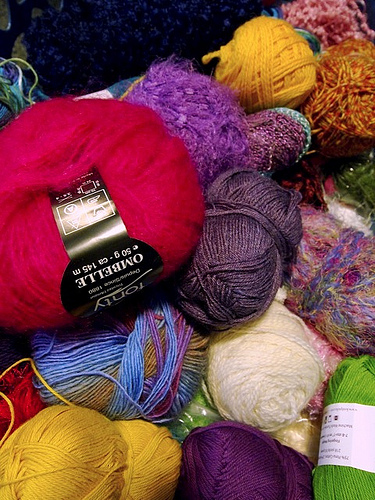Evaluating craft purchases: Can you afford it?

"I don't have any yarn," I thought, as I pawed through my huge storage bin full of yarn. It's a dilemma that is common to all crafters: Too often, we fall into the trap of confusing "shopping" with "crafting."
A lot of knitters (myself included) seem to forget that buying yarn is only part of the game. Being a knitter isn't about buying yarn - it's about knitting yarn into other things. The same is true for quilters, crocheters, scrapbookers, beaders and every other craft you can think of.
You want new stuff! You're bored of the stuff you have! But that little voice inside your head wants to know, can you really afford that next purchase? Here are some tools you can use to evaluate your shopping plans.
1. How much do you really have on hand already?
Denial ain't just a river in Egypt, it's also a common crafting strategy. Before you dig out your credit card for that next purchase, take a few hours (or days) to unearth ALL of your supplies. Lay them out, count them up, and tally your actual inventory.
The results will probably surprise you. I would guess that at least 75 percent of crafters don't actually know how much they have on hand. You can't evaluate your purchase unless you're honest with yourself about what you already own.
Even though I'm compulsive about maintaining my Stash page on Ravelry, I fall prey to denial just as much as anyone. A few years ago I decided to gather up all the extra bits and bobs of leftover yarn and donate them to a local senior center. I thought I had "maybe a shoebox full." But once I had rooted out all the leftover balls and partial skeins, it turned out to be three overflowing grocery store tote bags.

Image courtesy Flickr/vintagemodernquilts
Instead of choosing your project and then deciding which supplies you want to use, reverse the order and start with the supplies first. If you're a knitter, pick out a skein of yarn that you already own, which strikes your fancy, then decide what you can knit with it.
3. Set aside money just for crafting supplies
I know, no one wants to talk about budgeting. It's a bummer. But that doesn't detract from the fact that it's also a powerful tool for taking control of your spending. Whether you're skimming off a small percentage of your paycheck into a separate savings account, or stuffing dollar bills into a Mason jar, setting aside money for crafting supplies is a great way to go.

Image courtesy Flickr/meaganmakes
4. Analyze your purchasing past failures
When you look over your stash, what qualities cause supplies to land in there, instead of being used? Do you keep buying greens, even though it turns out you don't really like to use them? Do you buy a lot of sock yarn, even though you have yet to knit a pair of socks? (I myself have a bad habit of buying laceweight yarn, even though I have never yet knit a lace shawl.)
For some reason, we are often drawn to keep buying things that we never use. There are probably a lot of deep psychological insights that can be deduced from this, but let's save that for another day. The point here being, if you keep buying X and never use it, maybe you should think about not buying any more X.
5. Will it save you money down the road?
I have a Denise Interchangeable Needles kit which is the greatest example of saving money by buying something kind of expensive. The Denise kit cost me about $70, which seemed like a prohibitive amount of money to me at the time. However, it has spared me having to buy literally dozens of different sets of circular needles over the years.

Image courtesy Flickr/Homini:)
6. Would your money be better spent in a class?
The crafting world tends to emphasize purchasing supplies over experience, which is a real pity. Every local supply store (be it a yarn store, a bead store, a quilting store, or what have you) offers classes. These are usually very affordably priced, and are often geared toward working people, with classes scheduled for evenings and weekends.
Instead of spending money on more supplies, consider investing in improving your personal skill set. It's money well spent!
Main image courtesy Flickr/freakgirl

0 comments